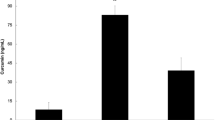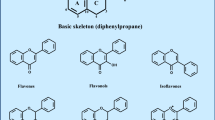Summary
Intensive sport and fitness practice are often correlated with oxidative stress and immunodepression which requires proper care to avoid tissue damage and reduced performance. Daily oral administration for 4 weeks of an Echinacea angustifolia plant cell culture extract containing 2.5 mg echinacoside in 20 subjects under high physical training resulted in a significant reduction in the blood levels of lipoperoxides, a systemic oxidative stress marker. Health benefits of Echinacea angustifolia cell culture extract are associated with improved safety and standardized quality deriving from the plant cell culture technology.
Similar content being viewed by others
References
Woelkart K, Linde K, Bauer R (2008) Echinacea for preventing and treating the common cold. Planta Med 74(6) 633–637
Islam J, Carter R (2005) Use of Echinacea in upper respiratory tract infection South Med J 98(3) 311–318
Speroni E, Govoni P, Guizzardi S et al (2002) Anti-inflammatory and cicatrizing activity of Echinacea pallida Nutt root extract J Ethnopharmacol 79(2) 265–272
Barrett B (2003) Medicinal properties of Echinacea: a critical review Phytomedicine 10(1) 66–86
Cundell DR, Matrone MA, Ratajczak P, Pierce JD Jr (2003) The effect of aerial parts of Echinacea on the circulating white cell levels and selected immune functions of the aging male Sprague-Dawley rat Int Immunopharmacol 3(7) 1041–1048
Roesler J, Steinmuller C, Kiderlen A et al (1991) Application of purified polysaccharides from cell cultures of the plant Echinacea purpurea to mice mediates protection against systemic infections with Listeria monocytogenes and Candida albicans Int J Immunopharmacol 13(1) 27–37
O'Neill W, McKee S, Clarke AF (2002) Immunological and haematinic consequences of feeding a standardised Echinacea (Echinacea angustifolia) extract to healthy horses Equine Vet J 34(3) 222–227
Currier NL, Miller SC (2001) Echinacea purpurea and melatonin augment natural-killer cells in leukemic mice and prolong life span J Altern Complement Med 7(3) 241–251
Goel V, Chang C, Slama J et al (2002) Echinacea stimulates macrophage function in the lung and spleen of normal rats J Nutr Biochem 13(8) 487–492
Bone J (2004) Echinacea: Quality, uses, and immunomodulating activity from a phytotherapist's perspectives. In: Echinacea: The genus Echinacea Miller SC, Yu H eds, CRC Press, Boca Raton, Fla, p 203–213
Bauer R (1999) Chemistry, analysis and immunological investigations of Echinacea phytopharmaceuticals. In: Immunomodulatory agents from plants Wagner H ed, Birkhauser Verlag, Basel, p 41–88
Fisher-Wellman K, Bell HK, Bloomer RJ (2009) Oxidative stress and antioxidant defense mechanisms linked to exercise during cardiopulmonary and metabolic disorders Oxidat Med Cell Longevity 2(1) 43–51
Letchamo W, Polydeonny LV, Gladisheva NO et al (2002) Factors Affecting Echinacea Quality. In: Trends in new crops and new uses Janick J, Whipkey A eds, ASHS Press, Alexandria, VA, p 514–521
Senchina DS, McCannb DA, Aspc JM et al (2005) Changes in immunomodulatory properties of Echinacea spp. root infusions and tinctures stored at 4†C for four days Clin Chim Acta 355(1–2) 67–82
Krochmal R, Hardy M, Bowerman S et al (2004) Phytochemical assays of commercial botanical dietary supplements eCAM 1(3) 305–313
Misawa M (1994) Plant tissue culture: an alternative for production of useful metabolite FAO Agricultural Services Bulletin 108 Food and Agriculture Organization of the United Nations
Tabata M (1976) Recent advances in the production of medicinal substances by plant cell cultures. Plant tissue culture and its Bio-Technological Application Proceeds First Int Congr Med Plant Res Sept 6–10, p 3–16
Dal Toso R, Melandri F (2009) Biotechnologically produced botanical ingredients. Ajuga reptans extract titrated in teupolioside Nutrafoods 8(3) 15–22
Aleo E, Ricci R, Passi S, Cataudella S (2005) A novel cyt C-H2O2-chemiluminescence assay for measuring the reducing/antioxidant capacity on hydrophilic and lipophilic antioxidants and biological samples Progr Nutr 3 154–182
Nahar L, Russel WR, Middleton M, Shoeb M, Sarker SD (2005) Antioxidant phenylacetic acid derivatives from the seeds of Ilex aquifolium Acta Pharm 55(2) 187–193
Kasugai S, Hasegawa N, Oguraa H (1990) Simple in vitro citotoxicity test using the MTT (3-(4,5) dimethylthiazol-2-yl)-2,5- diphenyl tetrazolium bromide) colorimetric assay: analysis of eugenol toxicity on dental pulp cells (RPC-C2A) Japan J Pharmacol 52(1) 95–100
Erdelmeier I, Gérard-Monnier D et al (1998) Reactions of N-methyl-2-phenylindole with malondialdehyde and 4-hydroxyalkenals. Mechanistic aspects of the colorimetric assay of lipid peroxidation Chem Res Toxicol 11(10) 1184–1194
Tai BH, Jung BY, Cuong NM et al (2009) Total peroxynitrite scavenging capacity of phenylethanoid and flavonoid glycosides from the flowers of Buddlejia officinalis Biol Pharm Bull 32(12) 1952–1956
Moreira A, Kekkonen RA, Delgado L et al (2007) Nutritional modulation of exercise-induced immunodepression in athletes: a systematic review and meta-analysis Eur J Clin Nutr 61(4) 443–460
Zhai Z, Solcoc A, Wud L et al (2009) Echinacea increases arginase activity and has anti-inflammatory properties in RAW 264.7 macrophage cells indicative of alternative macrophage activation J Ethnopharmacol 122(1) 76–85
Author information
Authors and Affiliations
Additional information
Echigena PluS™ is exclusively produced by IRB, Altavilla Vicentina, Vicenza, Italy - www.irbtech.com
Product Development
Rights and permissions
About this article
Cite this article
Dal Toso, R., Melandri, F. Echinacea angustifolia cell culture extract. Nutrafoods 10, 19–24 (2011). https://doi.org/10.1007/BF03223351
Issue Date:
DOI: https://doi.org/10.1007/BF03223351




